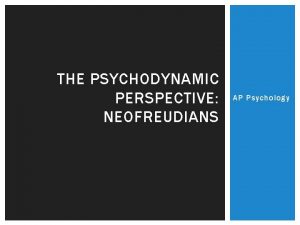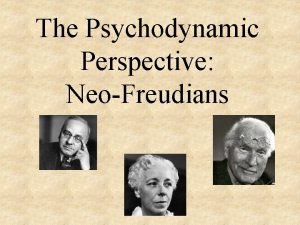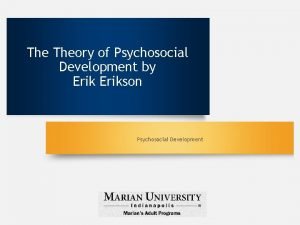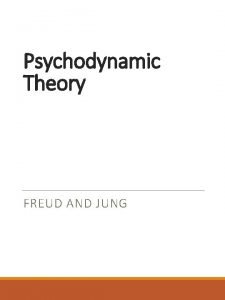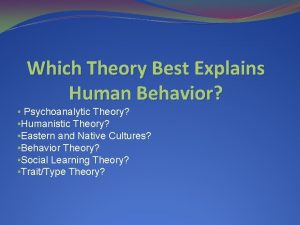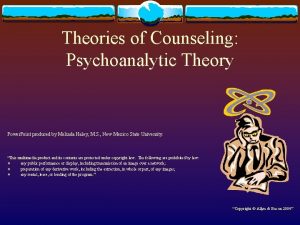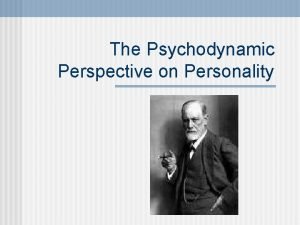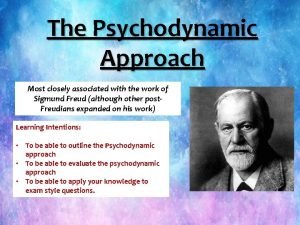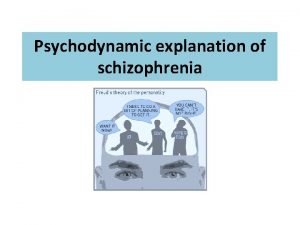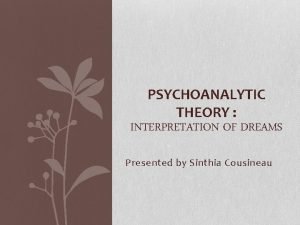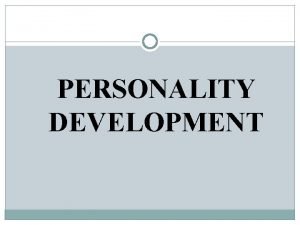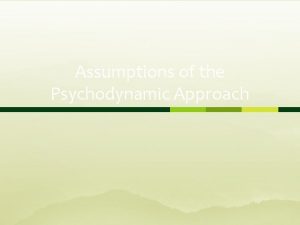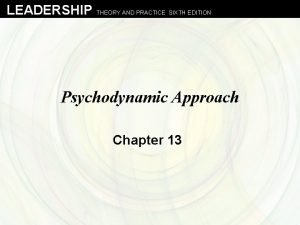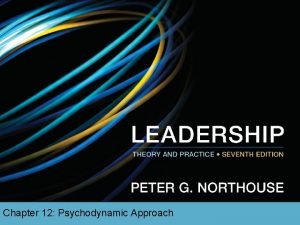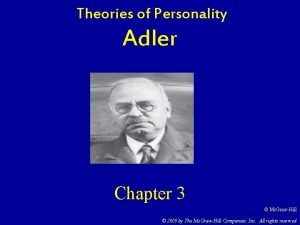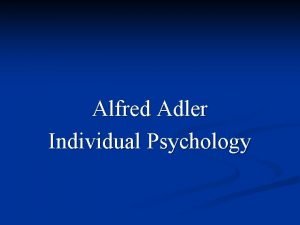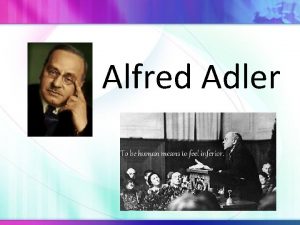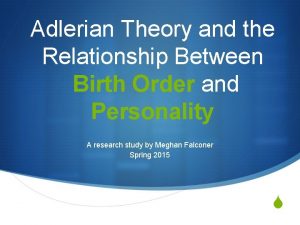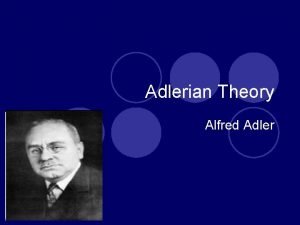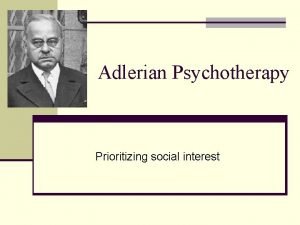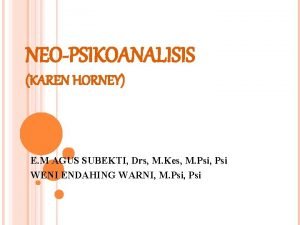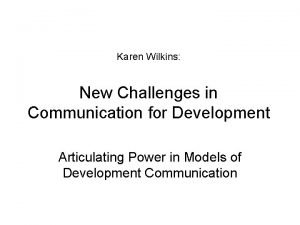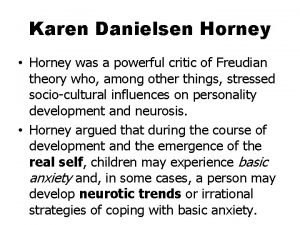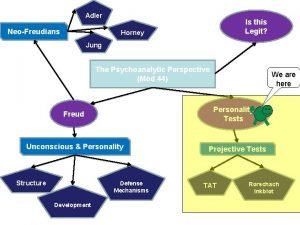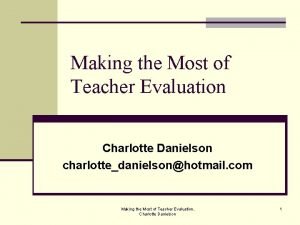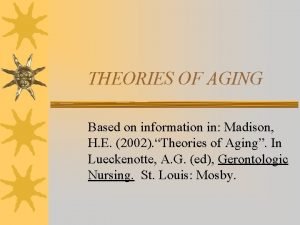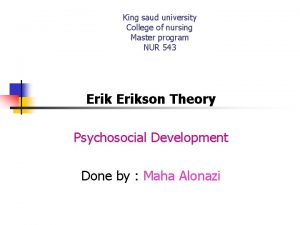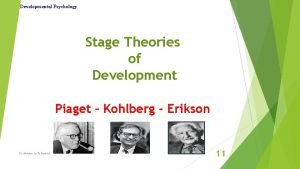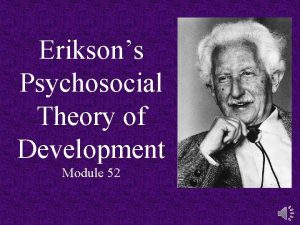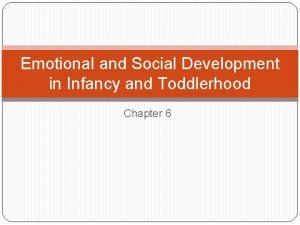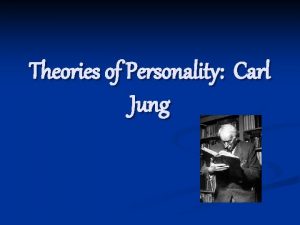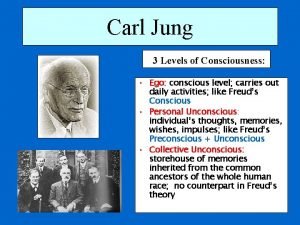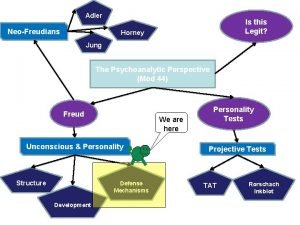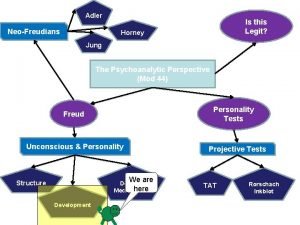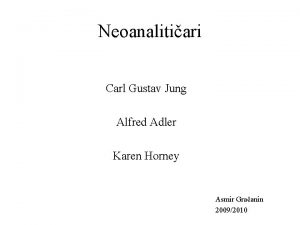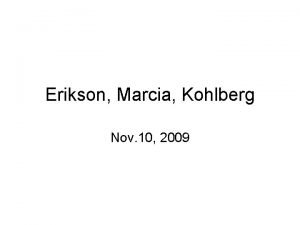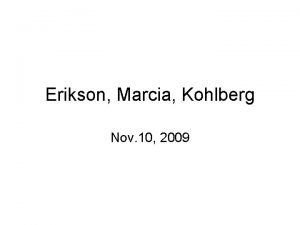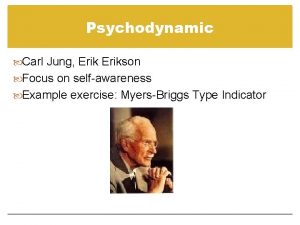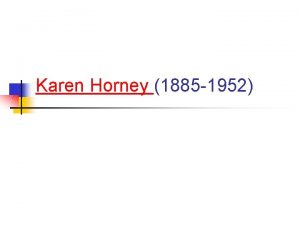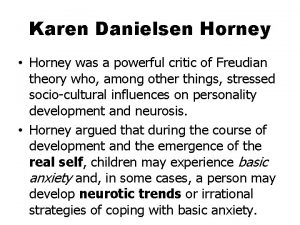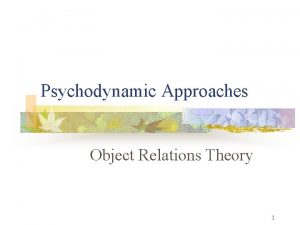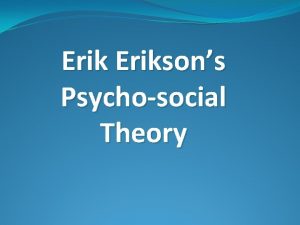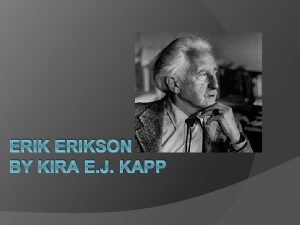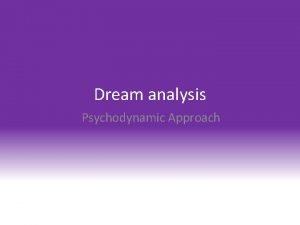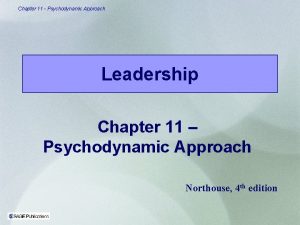Class 3 Psychodynamic Theory Jung Adler Horney Erikson










































- Slides: 42

Class 3 Psychodynamic Theory (Jung, Adler, Horney, Erikson)

Freud’s Psychoanalytic Theory There is a large rift between Freudian and academic psychology. As with the philosophical schisms between cognitive/behavioral and proximal/distal approaches, the split between academic and Freudian psychology has had a detrimental impact on the field. Like Skinner, Freud is much to blame for the difficulties. He was dogmatic about his claims and followers either pledged allegiance to the basic propositions of the psychoanalytic paradigm, or became neo-Freudians.

Freud’s Psychoanalytic Theory Compounding the problem of espousing an unchallengeable and unfalsifiable creed was the fact that Freud was wrong about many of his basic propositions. He claimed that there was a death instinct, and he was wrong. He argued that all drives were the derivatives of two motives of sex and aggression, and he was wrong. He argued that human females were biologically destined to be jealous of human males, and he was wrong. To be succinct, he was wrong in too many ways to count.

Freud’s Psychoanalytic Theory But because he was often wrong, does not mean that he was not also often correct (Westen, 1998). If we agree that Freud made significant contributions to our knowledge of human psychology, it must also be agreed that the fact that academic psychology pays so little attention to Freud is problematic. As is often the case in therapy, the task is to identify the dysfunctional split and to search for avenues that allow for a more functional integration.

Freud’s Psychoanalytic Theory In order to accomplish such an integration it is essential to keep two key points in mind. First, to empathize more effectively with Freud’s system of thought, it is necessary to remember both the method he used to acquire data for his theory and the cultural context in which both he and his patients were immersed. Emerging around the turn of the century in Victorian Europe, psychoanalysis is a pluralistic term that refers to a body of theory, the process of analyzing behaviors in terms of symbolic meanings and unconscious motives and conflicts, and a method of treatment centered on a long-term process of free association and interpretation (Aiken, 1993).

Freud’s Psychoanalytic Theory The socio-cultural backdrop and the contextual interrelationships between method, process, and structure in psychoanalysis are necessary to appropriately frame the issues and extract general meaning. The absence of such a frame can lead either to an early, blanket dismissal of Freudian thought as a collection of absurdities or to an unfortunate drowning in the metaphorical bottomless pit that characterizes much of psychoanalytic thinking.

From Freud to the JH: The Joint Point between Primates and Persons Animals Organisms Objects JUSTIFICATION HYPOTHESIS

There has been a strong and consistent shift ever since Freud from psychosexual motives to psychosocial motives, like attachment, power, love and freedom. Freud Neo Freudians Classic Drive Ego Object Relations Anna Freud Heinz Hartman Fairburn, Kernberg Major Figures Adler, Jung, Horney, Erikson (Bowlby) Attach -ment Theory Self Kohut Intersubjective Stolorow Modern Dynamic Thinkers Nancy Mc. Williams, Paul Wachtel, Leigh Mc. Cullough Valliant, Diana Fosha, Hanna Levenson

Discussion • Jung argued that there are “archetypes” that organize the human psyche. Does this idea resonate with you? What are some examples? • Can you identify a shadow side to your personality or in others? What does it look like and how does it show itself? How does it relate to the persona?

Carl Jung 1875 -1961 https: //www. youtube. com/watch? v=3 i. Li. KMUiy. TI Peterson on Jung

Key Points about Jung • Splits with Freud because he disagrees that sex is the primary driver of unconscious • Offers a complicated model of personality/self/human consciousness • Emphasizes the collective unconscious • Very broad/myth meaning making; philosophy/religion

Key Points about Jung • A great quote on the emergence of the “agentic self” I was taking the long road to school…when suddenly for a single moment I had the overwhelming impression of having just emerged from a dense cloud. I knew all at once: I am myself!. . . Previously I had existed, too, but everything merely happened to me…Previously I had been willed to do this and that: now I willed. This experience seemed to me tremendously important and new: there was “authority” in me. (cited in Ryckman, 2004, p. 75)

Jung’s Map of Psyche; Connected to the Modern Tripartite The self is the whole potential of an individual

Jung’s Analytical Psychology: Concepts and Principles v The psyche v. Principle of opposites, equivalence, entropy v. Ego v. Personal and collective unconscious v Archetypes v. God, persona, shadow, animus-anima, self

Jung’s Analytical Psychology: Personality Types Note that the MBTI, “personality” refers to an individuals preferred style of phenomenological focus and being in the world v Extraverted - Introverted v Thinking – Feeling v Intuition – Sensation v Judgment - Perception http: //www. myersbriggs. org/my-mbtipersonality-type/mbti-basics/

Jung’s Analytical Psychology: Personality Development v Self-realization v Neurosis and psychosis

Jung’s Analytical Psychology: Assessment Techniques v Dream Analysis v Method of Amplification v Word Association v Painting Therapy

The Neo-Freudians: From Freud’s Id to the Matrix

Discussion • According to Adler, feelings of inferiority are key drivers of psychosocial behavior. What do you think? • What are the key ingredients that go into a constructive (as opposed to destructive) life path? • Horney argued that many psychological problems could be characterized in terms of 10 neurotic needs, which she later consolidated into three personality types. Can you identify with particular needs that are salient, either in yourself or your clients? • According to Erikson, folks in your life stage (young to middle adulthood) must deal with the problems of intimacy versus isolation and generativity versus stagnation. Does this offer a reasonable summary of life challenges at this stage? Why or why not?

Alfred Adler 1870 -1937 Alfred Adler was born in Vienna, Austria. He suffered rickets as a young child which prevented him from walking until the age of four. Due to his health problems as a child, Adler decided he would become a physician and, after graduating from the University of Vienna in 1895 with a medical degree, began his career as an ophthalmologist and later switched to general practice. After connecting with Freud’s psychoanalytic ideas, he breaks from Freud (1911) because he sees the subconscious driving forces to be more social in nature than sexual.

Adler’s Individual Psychology: Concepts and Principles v The struggle for perfection v A teleological perspective: Purposeful striving for perfection, and superiority v Feelings of inferiority v Organ inferiority, masculine protest, overcompensation (Lord Farquaad) http: //www. youtube. com/watch? v=d 8 t. Pp. S 7 MI 6 s

For $600… On the Matrix this corresponds to Adler’s concept of Inferiority.

Adler’s Individual Psychology: Concepts and Principles v Creative evolution and social interests v Style of life and the creative self v Constructive versus Destructive Lifestyles The Adaptive Living Equation: R max VSB given f(P, E)

Adler’s Individual Psychology: Personality Development v Parental influence in early childhood v Birth order v First borns…Higher achievers, more conservative, more controlling v Later borns…More likely to rebel (e. g. , Sulloway’s Born to Rebel)

Adler’s Individual Psychology: Assessment Techniques v. Development of destructive or constructive lifestyles v. Life style types Ruling, getting, avoiding, socially useful Note: Some clear parallels with dimensions of the Influence Matrix (Power, affiliative, autonomous …socially useful effectively combines)

Adler’s Individual Psychology: Assessment Techniques v Early recollections v Dream analysis v Birth order analysis

Horney’s Social & Cultural Psychoanalysis Had ambivalent feelings about her father – loved him deeply, but feared his stern manner “If I could not be beautiful, I decided I would be smart. ” She believed strongly that Freud had placed too much emphasis on the role played by the sexual instincts and not enough on the cultural and social conditions that fostered psychopathology

A Central figure Basic Anxiety to Neurotic Needs Matrix/Re lational Style Meditation Horney Social and Cultural forces Cognitive Behavior Feminism https: //www. youtube. com/watch? v=KLOUy. R 99 cj. I

Horney’s Social & Cultural Psychoanalysis: Concepts and Principles v Hypercompetitiveness: The Unfailing Center of Neurosis: An indiscriminant need to compete and win and avoid losing at any cost to maintain sense of self-worth. v Basic Anxiety – The feeling of being isolated and helpless in a potentially hostile world v Neurotic Strategies – Protective devices that lead to temporary alleviation of anxiety, but create long term problems

Horney’s Social & Cultural Psychoanalysis: Concepts and Principles v Neurotic Needs v. NN to exploit others v. NN for affection and approval v. NN for social recognition and prestige v. NN partner to take over life v. NN for personal admiration v. NN to restrict one’s borders v. NN for power v. NN for personal achievement v. NN for independence v. NN for perfection and unassailability

For $600… On the Matrix, these correspond to Horney’s three relational styles

Horney’s Social & Cultural Psychoanalysis: Concepts and Principles v Three basic trends v. Compliant Types (move toward) v. Aggressive Types (move against) v. Detached Types (move away) v Basic Conflicts in Neurosis

Horney’s Social & Cultural Psychoanalysis: Critique of Freud v Do women really want to be men? v Do women really enjoy suffering? v Maybe Freud’s system exists in part because it justifies male domination? Thus, once again, what is peddled as explanation carries a clear element of justification legitimizing those in power.

Horney’s Social & Cultural Psychoanalysis: Humanistic View of Development v Everyone is special and could flourish under wise guidance v Alienation and Idealization v The tyranny of shoulds v Ideal v. Actual selves v Externalization

Horney’s Social & Cultural Psychoanalysis: Neurotic Defenses v Blind Spots v Compartmentalization v Rationalization v Excessive Self-Control v Arbitrary Rightness v Elusiveness v Cynicism

Erikson’s Psychoanalytic Ego Psychology Was probably an illegitimate child He never earned a university degree Wanted to be an artist Studied Native Americans and attempted to integrate psychoanalysis with history and anthropology

Erikson’s Psychoanalytic Ego Psychology v Ego Psychology: Liberalizing the Psychoanalytic Position v Portions of the ego are neither defensive nor controlled by biology, but often functions to help the individual adapt constructively to challenges… “a powerful agency that typically operates to promote health” v Human development occurs in stages that are universal, that is across humanity v Crisis, resolution and virtue

Development across the lifespan Social-Relational Needs Across Developmental Lifespan

At birth, Dependency Needs are central

As Infants Become Toddlers, Some Autonomy Needs Become Salient

Then Power and (Giving) Love Motives Emerge, in the context of an increasingly developed identity

Erikson’s Psychoanalytic Ego Psychology v The stages of development v Basic Trust v. Mistrust (Hope) v Autonomy v. Shame and Doubt (Will) v Initiative v. Guilt (Purpose) v Industry v. Inferiority (Competence) v Identity v. Role Confusion (Fidelity) v Intimacy v. Isolation (Love) v Generativity v. Stagnation (Care) v Ego Integrity v. Despair (Wisdom)
 Psychodynamic perspective ap psychology
Psychodynamic perspective ap psychology Adler psychodynamic theory
Adler psychodynamic theory Psychodynamic theory erikson
Psychodynamic theory erikson Regression defense mechanism
Regression defense mechanism Freud jung and adler
Freud jung and adler Consumer personality traits
Consumer personality traits Site:slidetodoc.com
Site:slidetodoc.com Psychoanalysis
Psychoanalysis Defense mechanism examples
Defense mechanism examples The psychodynamic perspective
The psychodynamic perspective Tripartite structure of personality
Tripartite structure of personality Psychodynamic perspective of schizophrenia
Psychodynamic perspective of schizophrenia Psychodynamic theory of dreaming
Psychodynamic theory of dreaming Sigmund freud psychodynamic theory
Sigmund freud psychodynamic theory Psychodynamic vs psychoanalytic
Psychodynamic vs psychoanalytic Defense mechanisms freudian
Defense mechanisms freudian Key assumptions of psychodynamic approach
Key assumptions of psychodynamic approach Psychodynamic approach to leadership
Psychodynamic approach to leadership Psychodynamic theory of leadership
Psychodynamic theory of leadership Theory of adler
Theory of adler Joseph adler psychology
Joseph adler psychology Alfred adler biography
Alfred adler biography Adler's birth order theory
Adler's birth order theory Adlerian therapy
Adlerian therapy Adlerian therapy
Adlerian therapy Teori kepribadian menurut karen horney
Teori kepribadian menurut karen horney 10 kebutuhan neurotik
10 kebutuhan neurotik Karen horney contribution to psychology
Karen horney contribution to psychology Karen danielson horney
Karen danielson horney Karen nnn
Karen nnn Stuart wilkins
Stuart wilkins Karen horney youtube
Karen horney youtube Children who release unexpressed
Children who release unexpressed Horney test
Horney test Danielson teacher evaluation scores
Danielson teacher evaluation scores Peck's expansion of erikson's theory
Peck's expansion of erikson's theory Erikson's psychoanalytic theory of development
Erikson's psychoanalytic theory of development Psychology stages of development
Psychology stages of development Industry erikson
Industry erikson Psychosocial stage: trust vs. mistrust
Psychosocial stage: trust vs. mistrust According to erikson's theory, a mistrustful baby
According to erikson's theory, a mistrustful baby Psychic inheritance jung
Psychic inheritance jung Self carl jung
Self carl jung
